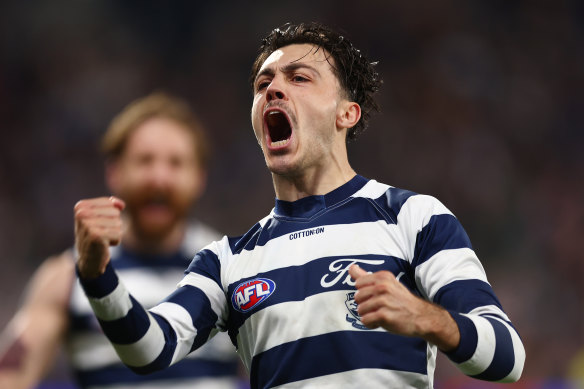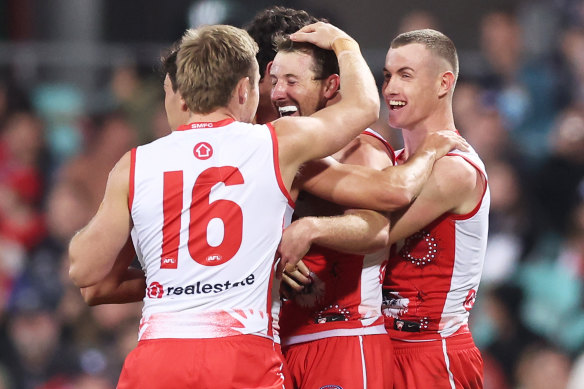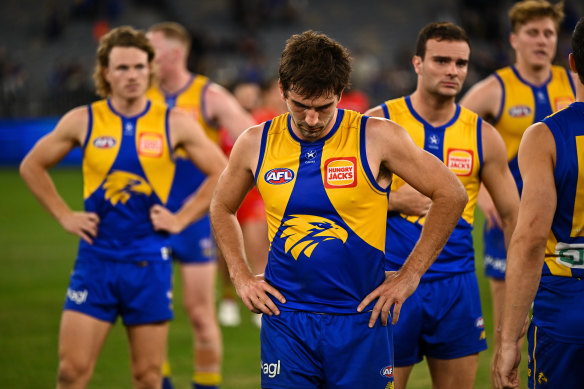By Sam McClure
Geelong and Sydney, renowned as two of the most successful football clubs in the past quarter of a century, have been named the happiest places to play football by their own players.
But the club languishing at the bottom of the table for player wellbeing, nearly three full points behind the Swans and the Cats in a rating out of 10, remains a secret.

Happy Cats: Geelong are league leaders in player wellbeing.Credit: Getty Images
AFLW players also reported less favourable scores on wellbeing and performance than their male counterparts, with a player survey showing they report lower overall wellbeing, despite experiencing higher levels of psychological safety.
The third edition of the AFL Players Association Insights and Impact report, which includes a survey that all AFL and AFLW players were invited to participate in at the end of last year, was released to clubs last month.
Each player was asked to answer questions on six different themes, essentially to gauge how each player was feeling at their club.
The themes included environment, player development and transition, as well as health, safety and wellbeing.
After players’ answers were reviewed by the players’ association, each club received a score out of 10. The clubs were then told their score and how it ranked comparative to the rest of the competition, but the scores of rival clubs were kept confidential.
Only two clubs finished with an overall score above nine, with the top club reporting a result of 9.51. Multiple sources at Geelong and Sydney, who spoke to The Scoop on the condition of anonymity due to the sensitive nature of the report, confirmed they were at the top of the pyramid.
Clubs ranked from third to 17th were extremely tight, but only one club delivered an overall statistical happiness rating of less than seven. The lowest club’s rating was 6.56. The average club score across the league was 8.28.

The Swans were a happy club in 2023.Credit: AFL Photos
The Scoop was unable to confirm the last-ranked club. Clubs contacted by this masthead either declined to comment or denied that it was them.
Clubs were emailed by the AFLPA late on Wednesday when it became apparent that this column was seeking further detail into the report. They were reminded that club results should remain confidential.
While wellbeing is hard to measure from the outside, the clubs who suffered miserable seasons on the field in 2023 are far easier to identify. West Coast and North Melbourne were on the receiving end of some catastrophic thrashings and both managed just three wins for the season.
The Kangaroos endured a torrid first season under Alastair Clarkson after myriad on- and off-field issues, some of which it must be said were out of the club’s control. And the Eagles, for so long a powerhouse of the competition, dealt with the weekly circus surrounding embattled coach Adam Simpson and his contract status.
The 16th-placed Hawks, while only managing seven wins with a percentage of 80, were viewed largely as a success story given the club’s vicious list cull in previous seasons.
Hawthorn staff and players also continued to deal with the ramifications of the racism saga that has been engulfing the club for the best part of two years.
Gold Coast had to sack and hire another coach in a 15th-placed season. Richmond, who finished 13th, endured a largely difficult season given the departure of three-time premiership coach Damien Hardwick.
Given the stability and success that Hardwick, chief executive Brendon Gale and the Tigers were able to maintain for so long, the 2023 season couldn’t have been easy on the playing group.

West Coast were wooden spooners in 2023.Credit: AFL Photos
The questionnaire given to each player, which has been seen by this masthead, asked a variety of questions.
For example, players were asked to provide a number value for certain statements, with one being “strongly disagree” and 10 being “strongly agree”.
The statements included:
- My club commitments allow adequate time for study and/or additional work placements.
- My club commitments allow adequate time for leisure, family/ other important relationships.
- My club commitments allow me to have a “mental break” from footy between matches.
Another key statement that AFL and AFLW players are asked to evaluate in the survey is: “I feel my club cares for me as a person, as well as a player”.
Caring for the younger generation of players has also never been more challenging for clubs, with players aged 18-21 reporting higher levels of anxiety than other players.
The AFLPA report lists social media as one of the most significant challenges for footballers coming into the system.
Each club’s football department and coaching methodology is also challenged, with players asked to comment on how well-supported they feel by the senior coach, assistant coaches, the player development manager and the football manager.
The report points out the concerns surrounding the overall wellbeing of AFLW players compared to their male counterparts.
“Despite higher levels of psychological safety, AFLW players experience lower overall wellbeing, higher psychological distress and score lower on key athletic coping skills,” the report states.
“These findings reveal a disparity in access to wellbeing resources and coping mechanisms, underscoring the critical need for focused efforts to improve AFLW players’ wellbeing.”
Keep up to date with the best AFL coverage in the country. Sign up for the Real Footy newsletter.